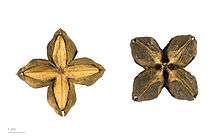Plukenetia volubilis
| Plukenetia volubilis | |
|---|---|
| | |
| Fruit of Plukenetia volubilis, Ecuador | |
| Scientific classification | |
| Kingdom: | Plantae |
| (unranked): | Angiosperms |
| (unranked): | Eudicots |
| (unranked): | Rosids |
| Order: | Malpighiales |
| Family: | Euphorbiaceae |
| Subfamily: | Acalyphoideae |
| Tribe: | Plukenetieae |
| Subtribe: | Plukenetiinae |
| Genus: | Plukenetia |
| Species: | P. volubilis |
| Binomial name | |
| Plukenetia volubilis L. | |
_Euphorbiaceae_Peru.png)

Plukenetia volubilis, commonly known as sacha inchi, sacha peanut, mountain peanut or Inca-peanut, is a perennial plant with somewhat hairy leaves, in the Euphorbiaceae. It is native to much of tropical South America (Suriname, Venezuela, Bolivia, Colombia, Ecuador, Peru, and northwestern Brazil), as well as some of the Windward Islands in the Caribbean.[1] It is now also being cultivated commercially in South East Asia, most notably in Thailand.
In the Amazon Rainforest in Peru, it has been cultivated by indigenous people for centuries, and will grow in warm climates up to altitudes of 1,700 meters (5,500 feet) as long as there is continued availability of water and good drainage. It grows better in acidic soils and alluvial flats near rivers.
The plant reaches a height of 2 m (6' 6"), with alternate, heart shaped, serrated leaves, 10 to 12 cm long (4"-4.7") and 8 to 10 cm (3.1-3.9") wide, that have petioles 2–6 cm (0.8-2.3") long. It flowers five months after being planted, and bears seeds around the eighth month. The male flowers are small, white, and arranged in clusters. Two female flowers are located at the base of the inflorescence. In tropical locations it is often a vine requiring support and producing seeds nearly year-round.
The fruits are capsules of 3 to 5 cm in diameter with 4 to 7 points, are green and ripen blackish brown. On ripening, the fruits contain a soft black wet pulp that is messy and inedible, so are normally left to dry on the plant before harvest. By two years of age, often up to a hundred dried fruits can be harvested at a time, giving 400 to 500 seeds a few times a year. Fruit capsules usually consist of four to five lobes, but some may have up to seven. Inside are the seeds, oval, dark-brown, 1.5 to 2 cm in diameter and 45 to 100 grams of weight. The cotyledons are open, similar to those of almonds, and covered with a whitish film. Raw seeds are inedible, but roasting after shelling makes them palatable.
The seeds of inchi have high protein (27%) and oil (35 - 60%) content, and the oil is rich in the essential fatty acids omega-3 linolenic acid (≈45-53% of total fat content) and omega-6 linoleic acid (≈34-39% of fat content), as well as non-essential omega-9 (≈6-10% of fat content).[2]
Modern uses
Sacha inchi oil has a mild flavour with a nutty finish and may be appropriate for a variety of cuisines, although when consumed daily after 1 week, some subjects indicated low acceptance for the oil.[3] Rich in alpha-linolenic acid, the oil was evaluated in a 4 month ingestion study (10-15 ml per day) by adults, showing it was safe and tended to increase blood levels of HDL cholesterol.[3]
In Peru during 2009, the humanitarian group Oxfam supported techniques for growing sacha inchi as a cash crop by indigenous groups like the Ashaninka.[4]
References
- ↑ Kew World Checklist of Selected Plant Families
- ↑ Guillén, María D.; Ainhoa Ruiz; Nerea Cabo; Rosana Chirinos; Gloria Pascual (August 2003). "Characterization of sacha inchi (Plukenetia volubilis L.) oil by FTIR spectroscopy and 1H NMR. Comparison with linseed oil". Journal of the American Oil Chemists' Society. 80 (8): 755–762. doi:10.1007/s11746-003-0768-z.
- 1 2 Gonzales GF, Gonzales C (2014). "A randomized, double-blind placebo-controlled study on acceptability, safety and efficacy of oral administration of sacha inchi oil (Plukenetia volubilis L.) in adult human subjects". Food Chem Toxicol. 65: 168–76. doi:10.1016/j.fct.2013.12.039. PMID 24389453.
- ↑ Hufstader, Chris (Winter 2009). "Looking to Sacha Inchi for their future". Oxfam Exchange. 9 (1): 2–3.